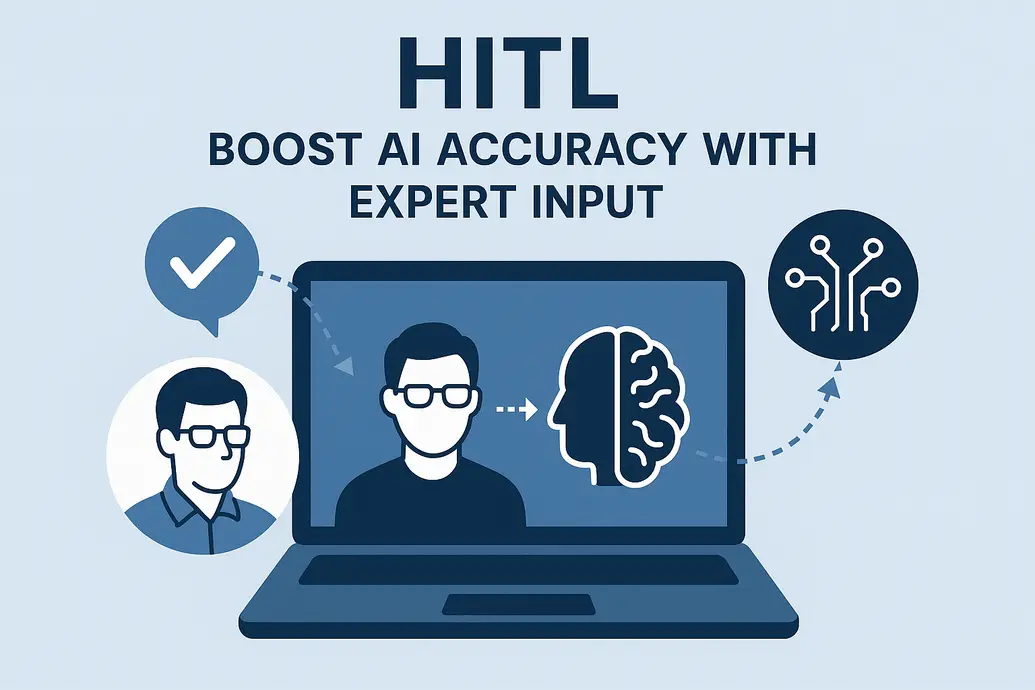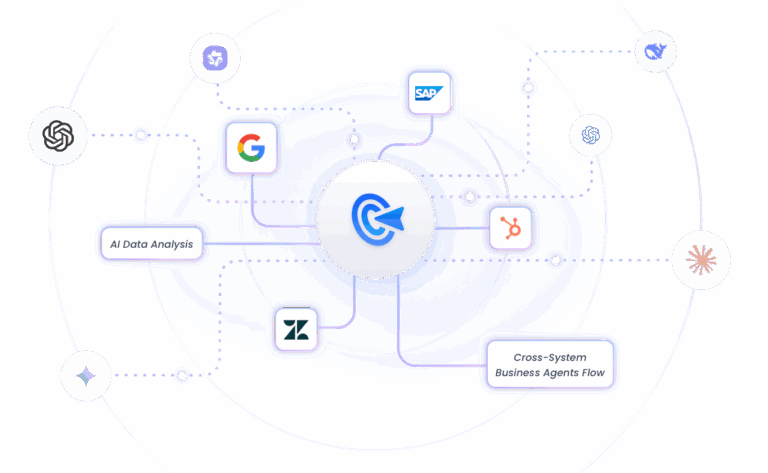1Understanding the Human-in-the-Loop (HITL) Concept
A Human-in-the-Loop (HITL) approach is a practice of integrating human intelligence directly into the workflow of an AI system. Instead of going for full automation, HITL places human input in training, validation, and correction of AI models.

In other words, HITL ensures humans remain active participants in the entire AI workflow lifecycle. The idea is to continuously improve the overall accuracy and efficiency of the AI system.
How Human-in-the-Loop (HITL) Works – HITL Techniques
Think of HITL not as a single action, but as a continuous, iterative cycle where humans and AI constantly teach and learn from each other. This collaboration occurs in various stages:
- Stage 1The Human Training
- This step is also called Data Labeling and Annotation. Humans provide the first layer of input by labeling or annotating raw data, like transcribing audio, categorizing text, or tagging images, e.g., cat, dog, stop sign, etc.
- Stage 2The AI Prediction
- After the model learns patterns from the labeled data, it is deployed to perform its task autonomously on new data. The AI begins generating predictions, but these early results often contain errors, gaps, or biases. Without eliminating these errors, an AI system can never meet the business-grade compliance or expectations.
- Stage 3The Human Validation
- In this stage, the AI's output is sent for human review based on specific triggers, like low confidence, borderline cases, or even random sampling. The experts' job is to:
- Confirms the AI's decision as correct.
- Corrects the AI's mistake.
- Refines the output for better accuracy.
Their corrections guide the model toward better accuracy and more efficient decision-making.
- Stage 4The Feedback Loop
- This is the most important part, as the human corrections aren't just a one-time fix. The corrected outputs are fed back into the AI model as new training data. The model learns from its mistakes and becomes more accurate and robust over time. Each loop reduces errors and strengthens the model's ability to handle new, unseen data. As the system gets smarter, it reduces the need for human intervention on the same issues in the future.
- Stage 5Continuous Monitoring
- Huamn-in-the-Loop does end even after deployment. The experts keep monitoring AI in real-world scenarios to step in whenever a new edge case, ethical dilemma, or unexpected system behavior occurs.
2Core Principles of Human-in-the-Loop
Human-in-the-Loop is built on certain guiding principles that ensure the AI remains accurate, ethical, and aligned with human needs.
1. Collaboration over Replacement
The central goal of HITL is not to replace humans but to augment their capabilities. AI handles repetitive, large-scale data processing at high speed, while humans contribute intuition, creativity, and ethical reasoning for complex or ambiguous situations.
AI should augment human abilities, not replace them. This way, they both complement each other.
2. Transparency
Because a human is involved in the process, the decisions can be explained and justified. This builds trust with end-users and stakeholders and is often crucial for regulatory compliance in industries like finance and healthcare.
3. The Continuous Feedback Loop
HITL is not a one-time setup. It's a dynamic, iterative process where human input is continuously fed into the AI system for re-training and improvement. This principle of continuous learning ensures that the AI doesn't become static but evolves with time.
4. Ethical Responsibility
One of the key principles of HITL is to incorporate human values, such as fairness, privacy, and accountability, into the AI model.
5. Scalability through Efficiency
The very purpose of adding a human element to AI is to make the overall system more scalable. With techniques like Active Learning, HITL promises an efficient model training process to balance efficiency with oversight. This makes the AI scalable across industries.
6. Bias Mitigation
All Human-in-the-loop AI models focus on using human oversight as a mechanism for minimizing bias. During training and monitoring, humans can identify, correct, and mitigate biases that an AI model may overlook. This results in an efficient system that operates in a fair, ethical, and transparent manner.
3Practical Business Use Cases of Human-in-the-Loop
Integrating Human-in-the-Loop (HITL) strategies is becoming a cornerstone of efficient AI implementation across industries. Businesses gain accuracy, accountability, and trust in their AI-driven systems by leveraging AI with human oversight.
Use Case 1: More Efficient Customer Support
AI-powered chatbots and virtual assistants are now the first point of contact in many customer service departments.
Key Issue: Bots can get stuck when questions are unusual or complex. Imagine a customer asking about a delivery delay due to customs clearance. The bot may not understand the exact concern, leaving them frustrated.
HITL Solution: With HITL in place, the chatbot handles routine, repetitive questions while transferring the conversation to a live human agent whenever it detects confusion. This results in:
- Faster service for simple questions
- No dead ends for complex queries
- Happier customers who feel heard
For businesses, this means improved customer satisfaction and stronger brand loyalty, without the need to hire an army of support staff.
Use Case 2: Smarter Fraud Detection in Banking and Finance
Today, many financial institutions rely on AI systems to detect and minimize fraud in digital activities. These systems automatically flag suspicious activity, such as:
- Abnormal spending patterns
- Account access from unfamiliar locations
- Multiple small transactions in a short time
- An unusual login attempt
Key Issue: Automated fraud detection can generate many false positives and unnecessarily block, causing inconvenience to the users.
HITL Solution: With HITL, these flagged cases are sent to human analysts to distinguish genuine fraud from harmless anomalies. Instead of directly blocking the transactions, they look at extra details like travel history or even contact the person directly.
This way, the human-in-the-loop process minimizes false alarms, protects customers, and ensures regulatory compliance.
Use Case 3: Content Moderation in Social Media
E-commerce sites, streaming platforms, and social networks rely on AI systems to process massive amounts of user-generated content daily.
Key Issue: AI tools scan posts, images, and videos at scale for catching violations like hate speech, violence, or spam. But tricky cases, such as satire, borderline language, or sensitive cultural references, are often misjudged by AI. It can lead to unfair removals or missed harmful content, which weakens user trust.
HITL Solution: A moderation system with human-in-the-loop uses AI to handle clear-cut violations while the borderline cases are transferred to human moderators for additional review.
Humans bring cultural understanding, contextual awareness, and ethical judgment to ensure content decisions are fair and aligned with community standards
Incorporate Human-in-the-Loop in Your Business
It can be a challenge for many organizations to put human-in-the-loop into practice due to technical complixity and scalability issues.
This is where GoInsight.AI makes a real difference.
It is a low-code AI platform designed to make HITL easy, scalable, and practical for businesses of all sizes. Without needing a team of engineers, companies can build AI systems that are fast, accurate, and guided by human judgment.

How does GoInsight.AI support HITL?
GoInsight.AI simplifies HITL by allowing businesses to:
- Add human review steps in AI workflows
- Scale oversight without slowing down operations
- Stay compliant with AI governance rules
- Use drag-and-drop tools, so even non-technical teams can manage HITL processes
5Key Challenges of Human-in-the-Loop That Need to Be Addressd
As good as it might be, HITL comes with challenges that organizations must carefully manage. Ignoring them can make human-in-the-loop counterproductive or costly instead of beneficial.
1. Operational Efficiency and Scalability
Integrating humans into an automated process inherently can create a bottleneck, especially when data volume grows. Too much human involvement can cancel out the speed advantage of AI and make it logistically complex.
How to Manage: Let AI handle routine cases automatically and bring humans in only when the AI is uncertain or when decisions are high-risk. Platforms like GoInsight.AI help set up these "checkpoints" smartly.
2. Cost of Human Oversight
Adding humans into the loop means employing domain experts to review AI outputs. So, the total cost of ownership for an HITL system must account for not just salaries, but also for recruitment, training, and management of staff.
For small businesses, this can feel expensive.
How to Manage: It's best to prioritize HITL for high-value, high-stakes decisions where error cost outweighs human labor cost. In addition, optimize the feedback loop to require fewer human interventions over time as the model improves.
3. Maintaining Human Consistency and Quality Control
Humans are not machines. They are likely to bring variability through fatigue, subjectivity, and differing skill levels. Two experts might label the same ambiguous data point differently. This can make the human-in-the-loop system inconsistent.
How to Manage: Establish clear, detailed, and unambiguous labeling guidelines. Train staff to recognize bias and use structured guidelines when reviewing AI results.
4. Integration Complexity
Building workflows that seamlessly connect AI outputs with human review can be technically difficult. Traditional systems may not support smooth handovers
How to Manage: Adopt platforms like GoInsight.AI that are designed with HITL in mind. Without needing heavy IT resources, a small business can integrate automation and human checkpoints.
6Final Remarks&FAQs
This article proves that human-in-the-loop is the future of responsible AI. If you want to get the best out of AI while keeping people at the heart of decision-making, GoInsight.AI is the tool you need. It helps companies adopt AI, with speed, accuracy, and human oversight, all built in.
Q: Why do businesses need HITL if AI is already smart?
AI is powerful but not perfect. It can misinterpret context, miss nuances, or make biased decisions. HITL ensures that important tasks are double-checked by humans for safety, fairness, and accuracy.
Q: Is HITL expensive to implement?
Overall, it can be expensive to build and deploy an HITL system compared to a traditional AI workflow. However, modern tools like GoInsight.AI reduce expenses by offering a low-code environment with built-in HITL capabilities.
Q: Which industries benefit the most from HITL?
HITL is useful across many industries, including:
- Healthcare
- Banking and finance
- Customer service
- HR and recruitment
- Social media and content moderation






Leave a Reply.